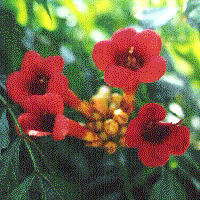 |
BIGNONIACEAE - The Bignonia Family
This is a family of around 650 species in 120 genera, found mainly in the tropics, particularly South America. Most species are woody, often climbing. They are grown for their timber and as ornamental plants, and include many plants frequently seen by travellers in tropical regions, as many species are used as street trees or in hotel gardens. Trees include African Tulip Tree (Spathodea campanulata), Jacaranda ovalifolia, the Tabebuias and Catalpas, and the climbers Pyrostegia venusta, Pandorea and Tecomaria. One or two may be grown outside in the milder parts of Britain, including Campsis radicans and Eccremocarpus scaber. The family also includes the well-known Calabash (Crescentia), used as a water container in many tropical areas. |
Characteristics of this Plant Family:
Leaves, Stem & Roots ~ Nearly all members of this Family have woody stems. The leaves are opposite, with no stipules, and are usually compound. There are often tendrils used for climbing. The calyx has five lobes, and is sometimes 2-lipped.
Flowers ~ The flowers are bell or funnel shaped, also with five lobes. They grow in clusters and are usually large and brightly-coloured. There are four stamens.
Seeds ~ The seedpod forms inside the flower (a superior ovary). The seeds are usually flat with papery wings, although sometimes there is an indehiscent fleshy fruit containing unwinged seeds (Kigelia).
Members of this Family usually have:
Bright trumpet-shaped flowers in clusters
Four stamens
A superior seed capsule containing flat winged seeds
No stipules
and are mostly tropical woody climbers